Canada’s long-track speed skaters debuted a suit thought to give a competitive advantage during the Pyeongchang 2018 Winter Olympics. While some research has shown up to a 10% reduction in aerodynamic drag with high-tech suits, other novel designs have produced limited effect. See what Canada’s top athletes are wearing at the ISU World Cup Speed Skating this February 7-8 at the Olympic Oval in Calgary, Alberta.
What’s one of the most significant barriers to tennis participation in Canada? Winter! Read the SIRCuit to learn how Tennis Canada is supporting municipalities to develop covered courts and increase access to the game.
It might be surprising to hear concussions are a serious risk in the sport of volleyball. But data collection from Volleyball Canada—dating back to 2016—has revealed exactly that.
“Our research has shown that about 1 in 10 youth athletes in Canada will sustain a concussion while playing club volleyball each year.” said Kerry MacDonald, Director, Sports Science, Medicine & Innovation, Volleyball Canada, referring to research done in partnership with the University of Calgary.
These numbers re-enforce what many in the volleyball community already knew: that concussions are part of the sport. But for those wondering how concussions happen in a sport with two teams separated by a net, Dr. MacDonald’s research also looked at causes. “Ball contact to the head is our primary mechanism of concussion,” said MacDonald, adding that falls to the floor are another contributor, “just not the primary cause.”
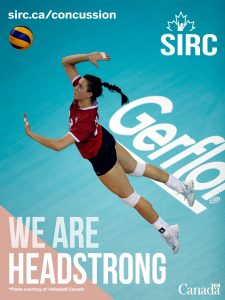
As a result of the findings, changes have been happening within the sport in Canada – big and small. Volleyball Canada has updated its concussion protocol, aligned with the Canadian Guideline on Concussions in Sport. The national body is also making specific policy changes to drills and training techniques. One example involves a common warm-up drill: a player attacks the ball over the net, then they would immediately go duck under the net to retrieve their ball.
“As they were doing that, their teammates were following behind them and doing the same thing, and basically hitting balls at them as they run through their court. So, we’ve made a policy change whereby athletes can no longer go under the net into that dangerous, high-risk area,” said Dr. MacDonald, adding that this specific change is being implemented this coming club season.
MacDonald’s team is also looking at equipment, paying close attention to emerging research on the different types of balls. “Preliminary data shows significant differences in the mechanical properties of various types/brands of balls. What we’re trying to understand is how certain properties could influence the risk of concussion, and that will hopefully drive decisions down the road in terms of which types we’re using for youth volleyball in Canada.”
Amid these progressive changes being made at Volleyball Canada, one of the biggest challenges remains the dissemination of information – educating athletes, parents, coaches and officials around the risks in volleyball.
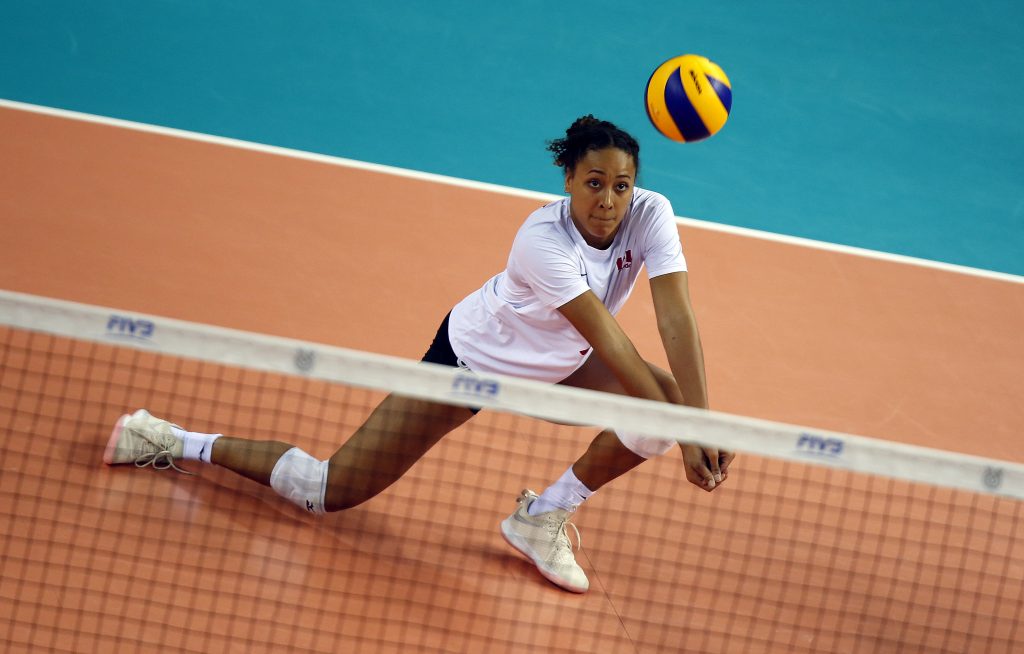
“Considering and learning about the value of harmonized approach and adopting that into our protocol has been critical,” said MacDonald. “Providing guidance based on evidence and best practices is something SIRC has really led on, and been incredibly helpful and beneficial for us as a NSO.”
Informed by data, volleyball’s decision-makers have been empowered to make important change. Proper education requires time, but the sport is doing everything in its power to create a safe environment.
This blog is part of SIRC’s #HeadstrongCanada concussion awareness, prevention and management campaign. The campaign features tools, resources, and best practices in managing and preventing concussions in sport in Canada. Developed in partnership with Sport Canada, Public Health Agency of Canada and other organizations, the toolkit offers credible information and templates recognized by stakeholders throughout the sport system.
Check out the concussion website for concussion information and tools to help your sport be concussion smart. For concussion information directly to your inbox, sign up for SIRC’s concussion newsletter.
By championing a mix of “hard goods and soft goods solutions,” Freestyle Canada has prioritized the creation of an environment in which athletes can test their limits without sacrificing safety or risking traumatic brain injuries. Learn more in the SIRC November Concussion Newsletter.
It’s a potent mix: dangerous flips and twists performed by young, boundary-pushing athletes who revel in the sport’s free-spirited culture.
More than most sports, concussions are a day-to-day, moment-to-moment risk for the freestyle skiing community. The five demanding disciplines – Aerials, Moguls, Halfpipe, Slopestyle and Big Air – put athletes in dangerous situations, hurtling down hair-raising mogul runs or twisting above metal rails and jumps.
“What makes it even more challenging is the sort of care-free culture in our sport,” adds Julie Steggall, former Winter Olympian who now serves as Director of High Performance, Slopestyle-Big Air & Halfpipe for Freestyle Canada. “We tend to attract creative athletes with a drive to try what hasn’t been tried before. They don’t necessarily weigh all the risks before they attempt a new trick or link a tougher run.”
In an effort to better protect their athletes from head injuries, Steggall says that education and awareness have been a high priority for years. Freestyle Canada was one of the first sports to embrace the “Making Head Way” module offered by the Coaching Association of Canada through the National Coaching Certification Program. In fact, they designed their own version of the module for Freestyle Skiing, which is mandatory for all coaches and on-the-ground officials.
Concussion-related resources, including policies, protocols, tools and other materials, are prominently displayed within Freestyle Canada’s online Resource Centre.
More recently, Freestyle has adopted what Steggall describes as “a combination of hard goods and soft goods solutions” to further protect their athletes from brain injuries.
On the hard goods side, there are investments in large airbags that provide a safer landing space for high performance athletes working on new skills. A change to a softer, rugby style helmet is also helping to cushion the blow if an athlete makes head contact with the airbag.
The soft goods solution involves a program called HeadStartPro. Courses are designed to stregthen the “wiring” in the minds of the athletes who are learning how to enhance performance and avoid injuries through better focus, awareness and mindfulness. When athletes are more aware of their state of mind – particularly if they’re frustrated, tired, rushed or complacent – they can make mental adjustments to prevent an injury before it happens.
“We’ve seen teams and sport academies reduce injuries by 30%-80% in the years they did our training,” says Mike Shaw, co-founder of the program, who was told he would likely never walk again after a catastrophic ski accident in 2013 left him temporarily paralyzed from the neck down. “What makes it resonate with the athletes is that the stronger mental approach means more than injury prevention – they’re performing better as well.”
Steggall was one of the featured speakers at a recent Concussion Prevention Workshop in Ottawa, hosted by Sport Canada and the Sport Information Resource Centre (SIRC). The SIRC website has become the “go to” hub for concussion-related research, tips and tools. It features the latest Canadian and international research as well as a suite of templates and sample products to help sport organizations at any level.
At the heart of SIRC’s awareness efforts are the “4 Rs” of concussion management that give clear direction to everyone involved in sport – 1) Recognize the signs and symptoms of a concussion; 2) Remove the athlete from the game or practice; 3) Refer the athlete to a healthcare professional; and 4) Return to school and then to sport based on the recommendations of a physician.
At Freestyle Canada, concussion prevention is a day-to-day preoccupation. Steggall says staff are constantly looking for ways to reduce the risks so athletes have every opportunity to attempt that next big trick safely and mindfully.
The five disciplines of Freestyle Skiing – Aerials, Moguls, Halfpipe, Slopestyle and Big Air – excite spectators with their gravity-defying skills, but put athletes in situations with high-risk for concussion. In this environment, education and awareness around concussion prevention and management is critical. Learn more about how Freestyle Skiing Canada empowered their athletes through “a combination of hard goods and soft goods solutions” in this month’s Concussion Champion Blog.
Tennis Canada’s mission is to lead the growth of the sport in the country. That mission can only be accomplished with more individuals playing more tennis more frequently. However, to increase participation rates, one important barrier needs to be addressed – winter. Enter Tennis Canada’s Covered Courts Program. This article discusses how Tennis Canada leveraged insights from a national survey to inform the development and implementation of this key program.
NATIONAL SURVEY FINDINGS
In 2018, Tennis Canada commissioned a nationwide study to assess the growth of tennis and assist with planning and key decision making for the years to come. The results, revealed in November 2018, found that just under 6.6 million Canadians, 18% of the population, had played tennis in the previous 12 months, with 69% of those having played at least four times. Arguably more impressive, almost three million Canadians are considered “frequent players,” meaning they play at least once a week in-season. Encouragingly, 97% of past-year players said they definitely or probably will play tennis again in the next year, while 36% of lapsed players and 14% of non-players intend to join them. These results clearly indicate that interest and participation in tennis is growing.
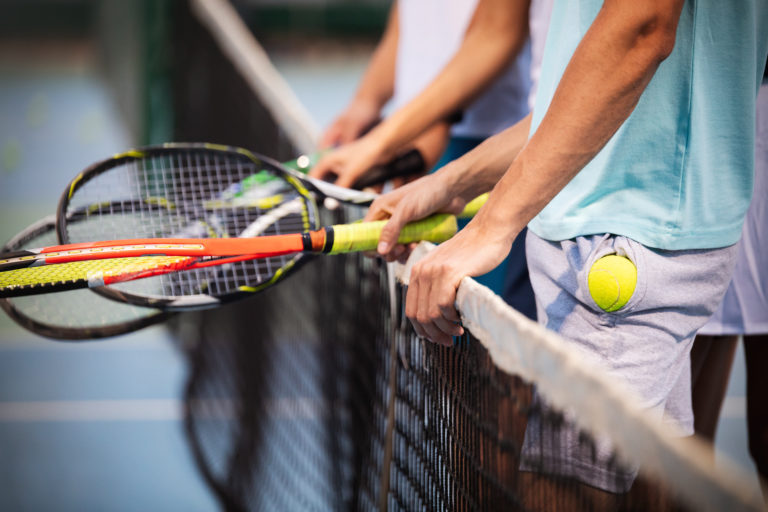
The results also discovered that participation is driven, in part, by high fan interest. The success of the current crop of top-level Canadian players, including 2019 U.S. Open champion Bianca Andreescu, Felix Auger-Aliassime, Denis Shapovalov and Milos Raonic, has contributed to that growth significantly. According to the 2018 study, tennis is ranked fifth of 14 sports in terms of fan interest (second in Quebec), but is first amongst individual sports. At the end of the 2018 season, Eugenie Bouchard and Milos Raonic occupied positions in the top five tennis players recognized and followed by Canadians, and were ranked higher than men’s World No. 1 Novak Djokovic, 17-time Grand Slam winner Rafael Nadal and previous winner of all four Grand Slams Maria Sharapova. Given the success of Canadians during the 2019 season, fan interest has undoubtedly continued to grow.
Another factor driving interest is safety. Among the ten most popular sports in Canada, tennis has second fewest injuries after baseball. This makes it an attractive option, especially for parents looking for low-risk sports for their children.
CONVERTING INTEREST INTO MORE RACQUETS IN HANDS
The growth in tennis participation and spectatorship is clear. However, without being able to convert that interest into more racquets in hands and players on courts all year round, those impressive figures count for less. The 2018 study found that 61% of Canadians played tennis on outdoor, public courts. However, due to Canada’s harsh winters, those courts are out of action for 50-75% of the year, limiting participation opportunities. With an average temperature of -6 degrees Celsius and more than 150 days of precipitation, who can blame players for staying away from the courts during the winter months?
To address this gap and stay true to its commitment to help every Canadian play tennis in any community, at any time of year, Tennis Canada created the Covered Courts Program. For Tennis Canada, increasing the number of covered courts aligns with their commitment to inclusivity and accessibility, complementing programming designed for all abilities and ages, from progressive tennis to wheelchair tennis.
ADDRESSING THE GAP IN COVERED COURTS.
According to CEO Michael Downey, “Canada has a dire shortage of accessible covered courts, especially compared to other leading tennis nations”. Of the municipally-owned tennis courts in Canada, only 2% are covered, compared to 34% of ice rinks and 37% of pools. Across the nation, there are just 750 covered courts, translating to approximately one indoor court for every 50,000 Canadians. In comparison, the Czech Republic (one covered court per 4,000) and France and Belgium (both with one covered court per 8,000) lead the way on a per capita basis.
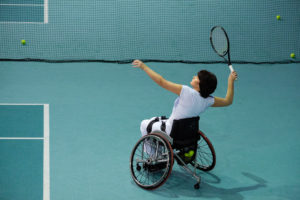
That is why Tennis Canada is focused on advocating for more affordable covered courts in municipalities across the country, ensuring Canadians have better access to these facilities throughout the entire calendar year. There is no doubt whether Canadians would buy-in. The 2018 study found that 90% of tennis players, those who play four or more times throughout the year, would play even more if there was a covered court nearby. What’s more, 51% of all Canadians, including those that haven’t picked up a racquet in over 12 months, agreed.
Covered courts can be part of an indoor facility or a domed facility (bubble courts). According to Tennis Canada research, for every six-court bubble, nearly 20,000 tennis matches are available to the community annually and four full-time coaching positions are created. Bubbles/Domes placed over pre-existing, no-cost, publicly owned, outdoor courts can be rented by residents during the winter for a reasonable $20 per hour but remain free to the public throughout the summer.
Results from the 2018 study showed high public support for the initiative: 90% of Canadians agree that municipalities should work with Tennis Canada on the Covered Court Strategy; 72% liked or loved the project; and 79% stated that partnering with Tennis Canada on the Covered Court Program would improve their opinion of a municipality. Tennis Canada has used these findings to inform decision-making and drive partnership development.
PARTNERSHIP FRAMEWORK
To increase the number of covered courts, a Municipal Tennis Facilities Strategy and Partnership Framework was developed by Tennis Canada over the last year to engage local governments and provide information on how they can help deliver more covered courts to their communities. The Framework is based on best practices and case studies of municipalities already working in partnership with external organizations to provide residents with access to more recreational activities. Covered court projects are excellent opportunities for municipalities to support their active living strategies and meet the growing demand for access to tennis, while ensuring a financial return on their investment. For several decades, tennis facilities across Canada have relied on air-supported structures—an effective solution to cover such open spaces.
The Municipal Tennis Facilities Strategy and Partnership Framework provides a step-by-step approach to ensure the municipal partnership development process is successful from a business standpoint and delivers relevant benefits to local residents. Tennis Canada understands that recreation service delivery objectives, initiatives and approaches vary from one municipality to the next, and the Framework has therefore outlined several capital and partnership options to help municipal organizations develop a covered court facility.
From youth team tennis to wheelchair tennis and senior leagues, the sport has a place in the lives of all Canadians, provided they have access to year-round facilities. Through strategic and operational partnerships, municipalities can bring more affordable and accessible year-round sport and recreation opportunities to their communities. Tennis serves to connect citizens and spark a passion for a life-long sport. Tennis Canada seeks to ensure that all participants across the nation can play tennis year-round, at any time of year. With the help and support of municipalities, this vision can become a reality.
RESOURCES
The study was conducted by Charlton Strategic Research Inc.
Sources: Canadian Tennis Participation & Interest Study (Charleton Insights, 2018), Covered Courts Program Partnership Assessment (Charleton Insights, 2018), College Sports-Related Injuries (Centres for Disease Control & Prevention, 2015), European Tennis report (International Tennis Federation, 2014)
For more stats, please consult our infographics on Tennis participation in Canada and on Tennis Facilities in Canada.
Para cyclists compete on bicycles (sometimes modified for prosthetics), tandem bicycles (for athletes with visual impairments), handcycles (used by amputee and paraplegic athletes), and tricycles (for athletes with impairments affecting their balance and coordination). Para cycling begins today at the Parapan American Games! Learn more about para cycling and follow the competition on the Canadian Paralympic Committee website.
In 2015, the Town of Milton, Ontario, constructed the $56 million Mattamy National Cycling Centre, which hosted the Toronto 2015 Pan Am/Parapan Am Games’ track cycling competitions. The Mattamy National Cycling Centre is the only indoor 250m cycling track velodrome in Canada. Milton hoped that staging the Pan Am/Parapan Am Games would enhance the visibility of track cycling and improve access to this unique sport community, inspiring cyclists of all ages and abilities and creating a track cycling culture for years to come. However, as evidenced in the literature, simply stating these goals/staging these events does little to ensure sustainable participation legacies (Misener, Taks, Chalip, & Green, 2015; Weed et al., 2015).
Event leveraging
With this in mind, our research team partnered with the Town of Milton and Cycling Canada to develop an event leveraging strategy. Event leveraging is based on the premise that targeted promotional strategies are necessary to achieve participation impacts from elite sport events (Chalip, Green, Taks, & Misener, 2017; Taks, Green, Misener, & Chalip, 2014). Strategic leveraging efforts are especially important for communities like Milton, which construct new facilities for previously unavailable sports. Unfortunately, little evidence exists about effective strategies for promoting novel sports in communities.
Developing and testing an event leveraging engagement strategy
In response to this deficiency, we designed a study to investigate the impact of distributing vouchers for free trial sessions to spectators attending Pan Am Games track cycling competitions. Our aim was to explore the efficacy of these vouchers in generating new participants to the sport.
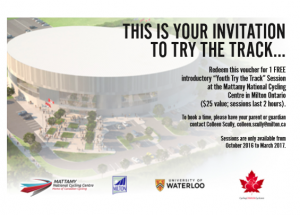
Our research team approached 338 spectators who had just watched track cycling at the Mattamy National Cycling Centre and asked to what extent they intended to try the sport. We then randomly assigned spectators into one of two groups. Those in the experimental group received a voucher to try track cycling within six months. Those in the control condition received $5.
Of those sampled, 40 spectators (12%) eventually tried track cycling following the Pan Am Games. Of those 40 who participated, 31 came from the voucher group and 9 came from the control group.
We found that the likelihood of participation for spectators who had low or no intentions and a voucher was 11%, compared to 10% for those who had high intentions but no voucher. The likelihood of participation for those with high intentions and a voucher was 21%, compared to 0% for those with low intention and no voucher.
Key Learnings
We concluded that the voucher was a powerful tool to promote track cycling, especially to engage those with low or no intentions to participate. The voucher program appeared to be a cost effective way to drive post-event engagement at the Centre. Receiving the voucher removed any cost-related barriers to trying the sport for the first time and made registering to participate easy. While the voucher seemed to be effective at getting people in the door, it is equally important for sport organizations to nurture newly formed relationships to ensure sustainable participation legacies.
Given fiscal and capacity constraints, we were unable to provide vouchers to all of the more than 6,000 spectators that watched these events over four days of competitions. We wonder if the participation trends we observed in our sample would have held across the larger population of spectators. If so, we would estimate the voucher program would have resulted in over 700 new participants to the sport.
While there is little evidence about the effectiveness of various event leveraging strategies, voucher programs represent an easy, low-investment initiative facilities and organizations can pursue as part of comprehensive sport promotional efforts. Future research should examine the efficacy of trial voucher programs in a variety of different domestic and international sport event contexts.
Further reading
Potwarka, L.R., Snelgrove, R., Drewery, D., Bakhsh, J, & Wood, L. (in press). From intention to participation: Exploring the moderating role of a voucher-based event leveraging initiative. Sport Management Review.
During Wimbledon, 53,000 tennis balls will be used. According to International Tennis Federation rules, every ball is hand-tested for its bounce, weight and compression, stored at 68°F, and replaced during a match after the first seven games, then every nine games. Used balls are sold, with proceeds going to the Wimbledon Foundation. Click here for more stats and facts from Wimbledon.
